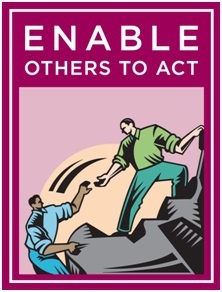The Five Practices of Exemplary Leadership®
Learn the Behaivors Common to all Exemplary Leaders



The Behaviors Most Often Practiced by Great Leaders: The Five Practices® Leadership Model
The Leadership Challenge® is a globally recognized leadership development framework that originated from research by Jim Kouzes and Barry Posner in 1983. Their goal was to understand what leaders do when they are at their personal best in leading others.
Through extensive research, they identified key leadership behaviors shared by those who achieve extraordinary results in organizations. These behaviors were organized into The Five Practices of Exemplary Leadership®—a proven model for effective leadership.
Today, The Five Practices® form the foundation of The Leadership Challenge Model, widely regarded as the standard for leadership excellence. This framework is the basis for leadership training programs, coaching strategies, and the LPI® 360 Assessment, helping individuals and teams develop the skills needed to model the way, inspire a shared vision, challenge the process, enable others to act, and encourage the heart—the essential practices of transformational leadership.
What are The Five Practices of Exemplary Leadership?

Model the Way: Modeling the way is about setting an example for others—this involves demonstrating the behaviors you wish for others to follow. To do this effectively, leaders must first understand themselves: their beliefs, their communication style, and how their values shape their actions. You'll know your leaders are modeling the way if they:
- Set a personal example of what they expect of others.
- Build consensus around a common set of values.
- Ask for feedback on how their actions affect other people’s performance.
- Make sure that everyone follows the agreed-upon principles and standards.
- Follow through on promises and commitments they make.
- Have a clear philosophy of leadership.

Inspire a Shared Vision: Leadership involves navigating an uncertain future and motivating others to join you on the journey. When leaders Inspire a Shared Vision, they have a clear destination in mind and are ready to create a compelling image for those around them. By initiating discussions about the future, they enable others to do likewise. Your leaders are inspiring a shared vision when they:
- Talk about future trends that will influence how work gets done.
- Describe a compelling image of what the future could be like.
- Appeal to others to share an exciting dream of the future.
- Show others how their long-term interests can be realized with a common vision.
- Paint the “big picture” of what they aspire to accomplish.
- Speak with genuine conviction about the higher meaning and purpose of their work.

Challenge the Process: Exceptional leaders seek ways to change the norm. Challenging the Process involves stepping back and finding ways to improve their work. It means taking initiative, driving change, and learning from challenges. By exploring new approaches, leaders can enhance both their organization and their journey to outstanding leadership. Your leaders are challenging the process when they:
-
Challenge people to try out new and innovative ways to do their work.
-
Actively search for innovative ways to improve what they do.
-
Ask “What can we learn?” when things don’t go as expected.
-
Identify measurable milestones that keep projects moving forward.
-
Take initiative in anticipating and responding to change.

Enable Others to Act: When you Enable Others to Act, it means strengthening your relationships with teammates and reflecting on what they need to do great work. This practice asks you to put effort into empowering others to create a work environment where people trust and respect each other. Think about how you can help the people you work with gain the confidence to excel, making your whole team stronger. Your Leaders Enable Others to Act when they:
- Develop cooperative relationships among the people they work with.
- Actively listen to diverse points of view.
- Treat others with dignity and respect.
- Involve people in the decisions that directly impact their job performance.
- Give people a great deal of freedom in deciding how to do their work.
- Ensure that people grow in their jobs by learning new skills and developing themselves.

Encourage the Heart: When you Encourage the Heart, it means telling your teammates how much you value and respect them—and by doing so, creating a workplace that people are genuinely excited to be a part of. This practice asks you to let people know you appreciate their hard work and are glad to have them on your team. Your Leaders Encourage the Heart when they:
- Praise people for a job well done.
- Make it a point to let people know about their confidence in their abilities.
- Creatively recognize people for their contributions to the success of a project.
- Publicly recognize people who exemplify a commitment to shared values.
- Tell stories of encouragement about the good works of others.
- Get personally involved in recognizing people and celebrating accomplishments.
Let's Connect
Let’s start a conversation about how we can help you elevate your leaders and team.





